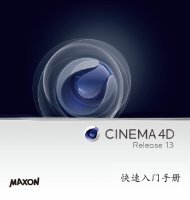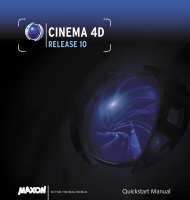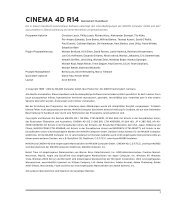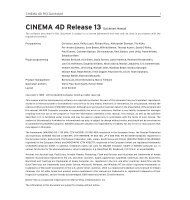Optional module - Maxon Computer
Optional module - Maxon Computer
Optional module - Maxon Computer
You also want an ePaper? Increase the reach of your titles
YUMPU automatically turns print PDFs into web optimized ePapers that Google loves.
CINEMA 4D R11 Quickstart – MOCCA<br />
6. Quick Tutorial – Morph Tool<br />
Now we‘ll turn our attention to the Morph tool. As previously mentioned, it is similar to the PoseMixer except<br />
that it makes it easier to create poses. There’s no need to create copies of the original mesh when using the<br />
Morph tool. A single tag is all that’s needed to store the poses (the Morph tag). Among other things, this means<br />
file sizes are much smaller than when using PoseMixer.<br />
In this chapter, we’ll take a closer look at the Morph tool and on the way explore the joint driven morph function.<br />
The basic principle when creating facial poses is simple: add a Morph tag to the mesh, create “morph targets”<br />
and move the points around to model the emotions in the morph targets. Simple. But there’s more...<br />
Open the file “QS_Morph_Start.c4d”. This file contains two animations for the same arm. The only difference<br />
is that the left arm uses a joint driven morph to improve the deformation and simulate muscles. In this case,<br />
the morphing is linked to the rotation of the second joint. Rotating this joint by -90 degrees around its X-axis<br />
morphs the mesh to the morph target.<br />
Once you’ve finished looking at the example, open the file “QS_Morph_Final.c4d”. This contains the animated<br />
arm before it has been morph-optimized. We need to add a Morph tag before we can use the Morph function.<br />
Create the tag by right-clicking on the “arm_mesh” in the Object Manager and choosing Character Tags/Morph.<br />
Notice that the Morph tag already contains a base morph and morph target in the Attributes manager — they<br />
were assigned automatically.<br />
The base morph is our starting position and cannot be deleted. The morph target is the target pose you need<br />
to model. Unlike the base morph, you can freely create and delete morph targets.<br />
Choose Cameras/Top in the editor to view the arm from above. Select the Morph tag if it isn’t already selected<br />
and enable the “Auto Joint Driven” option in the Attribute Manager (more about this option later on). Click on<br />
the “Morph Target” in the Attribute Manager and select the Points tool. Select two points in the area of the<br />
biceps and move them down a little.<br />
181









